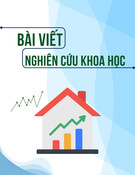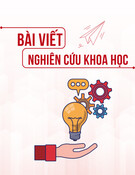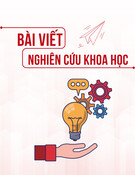
http://www.iaeme.com/IJMET/index.asp 22 editor@iaeme.com
International Journal of Mechanical Engineering and Technology (IJMET)
Volume 10, Issue 04, April 2019, pp. 22-30, Article ID: IJMET_10_04_004
Available online at http://www.iaeme.com/ijmet/issues.asp?JType=IJMET&VType=10&IType=4
ISSN Print: 0976-6340 and ISSN Online: 0976-6359
© IAEME Publication Scopus Indexed
THE EFFECT OF CONTINUOUS
RECONFIGURATION CAPABILITY ON
DISRUPTIVE BUSINESS MODEL INNOVATION
STUDY ON INDONESIA DIGITAL STARTUPS
Kurnadi Gularso
Binus Business School, Doctor of Research in Management
Bina Nusantara University, Jakarta, 11540, Indonesia
Tirta Nugraha Mursitama
International Relations Department, Faculty of Humanities
Bina Nusantara University, Jakarta, 11480, Indonesia
Pantri Heriyati, Boto Simatupang
Binus Business School, Doctor of Research in Management
Bina Nusantara University, Jakarta, 11540, Indonesia
ABSTRACT
Several studies have indicated that digital (tech) startups’ behaviors tend toward
disruptive business model innovation in facing volatility, uncertainty, complexity,
ambiguity (VUCA) environment. One of the necessary capabilities to perform such
innovation as well as to attain an excellent firm operational performance is continuous
reconfiguration capability. This paper aims at examining the effect of continuous
reconfiguration capability on disruptive business model innovation on Indonesia digital
(tech) startups. This study applied a quantitative method with a partial least-squares
structural equation modeling (PLS-SEM) approach to analyze the data obtained. The
survey was used to understand the perceptions of Founders/C-Level out of 107
Indonesia startups. This study showed an essential contribution to the literature about
the role of transformational capability viz continuous reconfiguration capability for
digital (tech) startups as an initiator in executing disruptive business model innovation.
The study recommends startups to have this capability that should be followed by
determining strategic orientations, especially entrepreneurship orientation, market
orientation, and technology orientation.
Key words: Continuous reconfiguration capability, Disruptive business model
innovation, Digital startups

Kurnadi Gularso, Tirta Nugraha Mursitama, Pantri Heriyati, Boto Simatupang
http://www.iaeme.com/IJMET/index.asp 23 editor@iaeme.com
Cite this Article: Kurnadi Gularso, Tirta Nugraha Mursitama, Pantri Heriyati, Boto
Simatupang, The Effect of Continuous Reconfiguration Capability on Disruptive
Business Model Innovation Study on Indonesia Digital Startups, International Journal
of Mechanical Engineering and Technology 10(4), 2019, pp. 22-30.
http://www.iaeme.com/IJMET/issues.asp?JType=IJMET&VType=10&IType=4
1. INTRODUCTION
Today, in the era of the digital economy, digitization has urged and promoted the
implementation of business model innovation in incumbent and startup business (Hafkesbrink
& Schroll, 2010; Birkinshaw & Ansari, 2015; Teece & Linden, 2017). Further, digital (tech)
startups – hereafter in this paper is named “startups” – should create disruptive business model
innovation to achieve a significant growth and viable business (PwC, April 2013); Balboni,
Bortoluzzi, Tivan, Tracogna, and Venier, 2014; O’Connell, Delaney, & Moriarty, 2015).
However, there is scant research on disruptive business model innovation by startups as the
initiator. There are also a few research on the antecedents of disruptive business model
innovation as first mover strategy particularly in the startups' industry which is facing VUCA
(volatility, uncertainty, complexity, ambiguity) business environment.
Dynamic capabilities have long been believed to be the ability of businesses to face fast-
moving business environments which are characterized by rapid technological change (Teece,
2007) which is currently known as VUCA. Three dimensions of dynamic capabilities are
sensing, seizing, and reconfiguring. Reconfiguring as a transformation capability plays an
important role especially in the implementation of innovation. Reconfiguration should be
continuously conducted to accommodate the continuous innovations being implemented in
ever-changing and uncertainty environments.
Startups have an entrepreneurial mentality that encourages them to search and create new
opportunities to serve their targeted customers. Startups also have always to respond to the
market changes and technological turbulence to make them viable and continue managing
significant growth. Strategic orientations will align the startups’ organization to manage their
goals.
The research question here is “What are the effect of continuous reconfiguration capability
on strategic orientation and eventually the achievement of disruptive business model innovation
of Indonesia startups?” Hence, the general objective of this research is to understand the
importance of building continuous reconfiguration capability for startups to make their business
viable and get significant growth. The benefit of this study is to contribute to the theory that
continuous reconfiguration capability requires the mediation of a strategic orientation for
startups in applying the disruptive business model innovation.
2. LITERATURE REVIEW
‘Dynamic capabilities’ is the firm’s ability to integrate, build, and reconfigure internal and
external competencies to address rapidly changing environments. These enterprise capabilities
are difficult to replicate and should adapt to changing customer and technological opportunities
(Teece, Pisano, & Shuen, 1997; Teece, 2007). Reconfiguration or transformation entails
recombining and modifying existing resources (Teece, 2014).
The continuous aspect of reconfiguration capability is essential to respond to the ever-
changing environment such as customers, competitors, and technologies (McGrath, 2013;
Teece, 2014). Hawass (2014) suggested after his finding, to effectively develop a
reconfiguration capability, a firm has to continuously participate in technological alliances and
develop a close cooperative relationship with suppliers, customers, and rivals to acquire updated
product-market information.

The Effect of Continuous Reconfiguration Capability on Disruptive Business Model Innovation
Study on Indonesia Digital Startups
http://www.iaeme.com/IJMET/index.asp 24 editor@iaeme.com
In this research, continuous reconfiguration capability is defined as “the ability to transform
by continually rearranging the company's resources in the form of intangible resources (such as
capabilities) and tangible resources,” (McGrath, 2013; Banjongprasert, 2013; Teece, Pisano, &
Shuen, 1997; Eisenhardt & Martin, 2000; Wang & Ahmed, 2007; Barreto, 2010).
Strategic orientation represents aspects of leadership. It refers to one of eight dimensions of
the leadership competency, i.e., critical thinking (Chung-herrera & Lankau, 2003). A growing
stream of studies today endorse the adoption of different strategic orientations such as
innovation orientation, technology orientation, entrepreneurial orientation, quality orientation,
and productivity orientation (Voss & Giraud, 2011; Zhou, Yim, & Tse, 2005). Entrepreneurial
orientation and learning orientation may combine or act in between the market orientation and
technology orientation (Schindehutte, Morris, & Kocak, 2008; Hakala, 2010).
The implications of strategic orientation are innovation capability/innovation success and
competitive advantage towards market performance (Tutar, Nart, & Bingöl, 2015); market
performance and financial performance (Hsu, Tsai, Hsieh, & Wang, 2014); firm performance
(Mohd, Mohd, Mamun, & Breen, 2017; Gergely, 2016); organizational performance (Obeidat,
2016; Al & Province, 2016); business performance (Fernandes & Solimun, 2017), corporate
entrepreneurship (Kakapour et al., 2016), growth with related resource moderation, (Gupta &
Basu, 2014).
Startups generally conduct strategies through DBMI, which is new to the industry because
the business model is the primary driver to a startup’s growth (Balboni, Bortoluzzi, Tivan,
Tracogna, & Venier, 2014;(PwC, April 2013). Many DBMIs searches for opportunities from
unserved customers through low-cost offerings. That they will eventually take over the
incumbents’ market share (Charitou, C. & Markides, C., 2003; Markides, 1997, 1998, 2006),
as initiators of DBMIs, their explorative intentions are driven by perceptions of performance-
reducing threats and risk experience (Osiyevskyy & Dewald, 2015).
The theoretic objective of this research was primarily to predict and identify the effect of
continuous reconfiguration capability on disruptive business model innovation with the
guidance of strategic orientation, as depicted in Figure 1. The relationship between continuous
reconfiguration capability and strategic orientation as well as DBMI was set out in the following
three hypotheses:
Figure 1 Conceptual Model
H1: Continuous reconfiguration capability is positively related to strategic orientation.
H2: Strategic orientation is positively related to disruptive business model innovation.

Kurnadi Gularso, Tirta Nugraha Mursitama, Pantri Heriyati, Boto Simatupang
http://www.iaeme.com/IJMET/index.asp 25 editor@iaeme.com
H3: Continuous reconfiguration capability is positively related to disruptive business model
innovation.
3. RESEARCH METHODS
For the purpose of this study, a quantitative research method was applied with particular
reference to an empirical survey with the Partial Least Squares-Structural Equation Modeling
(PLS-SEM) approach to analyze the data. The data were obtained by using questionnaires with
a Likert scale (1-4: Strongly disagree, Disagree, Agree, Strongly Agree), from respondents of
Founder/C-Level Indonesia startups. The respondents were chosen randomly from the
population of DailySocial, an Indonesia digital media startup.
The study collected the data using a cross-sectional survey method with a questionnaire that
consists of two parts: fill in information and Likert scale statements. The questionnaires were
then distributed online through personal accounts, and a small amount was offline directly to
the Founders/C-Level of Indonesia startups. This data collection took around five months, from
January to May 2018.
The total amount of Indonesia startups was recorded as 772 startups. Further, an amount of
265 questionnaires were distributed to the respondents who were taken randomly from the
population. The returned questionnaires were 107 or equal to 40.4% response rate.
4. RESULTS AND DISCUSSIONS
Descriptive analysis of the data from the “filling in” and “Likert scale” questionnaire together
with the findings from some interviews and focus group discussions with Founders/C-Levels,
and their related stakeholders would enrich the interpretative explanations.
The respondent startups' types are SaaS, Media, On-Demand, E-Commerce, Marketplace,
Fintech, Agtech, Edtech, Member Loyalty, and Others. The operating period of the majority of
startups is around three years and below with a total of 78 (72.9%), which means that only 29
(27.1%) startups are more than three years old. Sales performance of majority startups as many
as 56 (52.3%) are at levels above one billion rupiahs, 40 (37.4%) are at levels below one billion
rupiahs, and the remaining 11 (10.3%) are not willing to state their sales performance. With
sales growth of under 10% per year of 16 (15.0%); between 10% to 20% per year as much as
20 (18.7%); between 20% 50% per year as much as 24 (22.4%); and the majority or as many
as 47 (43.9%) have sales growth of above 50% per year. However, only 37 (34.6%) stated that
they had enjoyed profits, while the remaining 70 (65.4%) had not.
Five questions that are used as indicators related to continuous reconfiguration capabilities
are changes in organizational structure, marketing method or strategy, technological equipment
or manufacturing process; aspects of renewing business processes and
production/manufacturing processes; and the social-networking aspect with all values above
70% with a standard deviation between 0.62 to 0.72. The six indicators related to strategic
orientation are entrepreneurship orientation (innovativeness and risk-taking), market
orientation (competitive aggressiveness, customer orientation, and competitor orientation), and
technology orientation (technological turbulence). The four indicators related to disruptive
business model innovation are value creation (new capabilities); value proposition (new
customer relationships); new market disruptive innovation; and low-end market disruptive
innovation (efficient products/services). Score items are relatively high which are all above
80% with a standard deviation between 0.60 to 0.70.

The Effect of Continuous Reconfiguration Capability on Disruptive Business Model Innovation
Study on Indonesia Digital Startups
http://www.iaeme.com/IJMET/index.asp 26 editor@iaeme.com
Table 1 Results Summary for Reflective Measurement Models
Latent Variable
Indicators
Loadings
Indicator
Reliability
Cronbach
Alpha
Composite
Reliability
AVE
Discriminant
Validity
CRC
crc_1
0.754
0.569
0.836
0.883
0.601
Yes
crc_2
0.769
0.591
crc_3
0.794
0.630
crc_4
0.812
0.659
crc_5
0.747
0.558
SO
so_1
0.623
0.388
0.798
0.858
0.508
Yes
so_2
0.513
0.263
so_3
0.692
0.479
so_4
0.827
0.684
so_5
0.813
0.661
so_6
0.756
0.572
DBMI
dbmi_1
0.718
0.516
0.740
0.835
0.560
Yes
dbmi_2
0.784
0.615
dbmi_3
0.763
0.582
dbmi_4
0.725
0.526
Rather than applying the Cronbach's alpha, Hair et al. (2014) prescribe applying composite
reliability to quantify internal consistency, in which all outcome values are within and above a
satisfactory range of 0.70 to 0.90, (Nunnally & Bernstein, 1994). All AVE values are above the
0.50 threshold. It means the constructs illustrate the more significant part of the variance of its
indicators. Table 1 presents the reflective measurement models.
The significance of the path coefficients, the t-values, the level of R2 values, and the
predictive relevance (Q2) will evaluate the structural models. While, the goodness-of-fit (GoF)
measurement is not necessarily to be used (Hair et al., 2014). R2 values express that exogenous
latent variable CRC explains 14.6% of the variance in the endogenous latent variable SO.
Likewise, the latent variable SO explains 36.2% of the variance in the endogenous latent
variable DBMI. The R2 value of DBMI is above 0.25, hence the number of sample size in this
research (107) is adequate, (Cohen, 1992). All Q2 values are higher than 0, which implies that
the exogenous construct has predictive relevance for the two endogenous constructs SO and
DBMI.
The path coefficient values which are aligned with the t-values. T-values determine the
significance of the relationship between two variables with the minimum value of 1.96 is
considered as a significance relation. The threshold derived from a two-tailed test with a
significance level of 5%. Under this criterium, the results concluded that CRC has a significant
positive influence to achieve SO and subsequently SO has a significant positive influence in
attaining DBMI. However, the results also showed that CRC does not have a significant direct
effect on DBMI.
Following, examine the mediating effect of SO in this research model by directly analyzing
the relationship between CRC and DBMI by removing the SO variable. The analysis shows
that this relationship has a path coefficient of 0.357 with t-value of 3.933. These results indicate
that CRC has a significant positive relation with DBMI. For this reason, the mediating effect of
SO is calculated, with the VAF (Variance Accounted for) result is 57.5%. Because this result




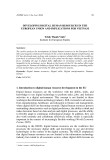
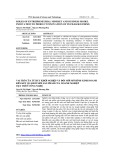
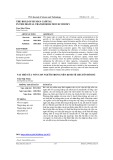
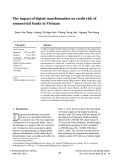
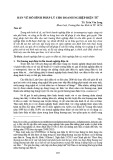
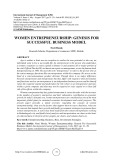
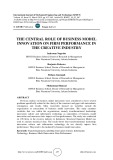
![Bộ câu hỏi trắc nghiệm Đổi mới và sáng tạo [mới nhất]](https://cdn.tailieu.vn/images/document/thumbnail/2025/20251007/kimphuong1001/135x160/56111759828894.jpg)





